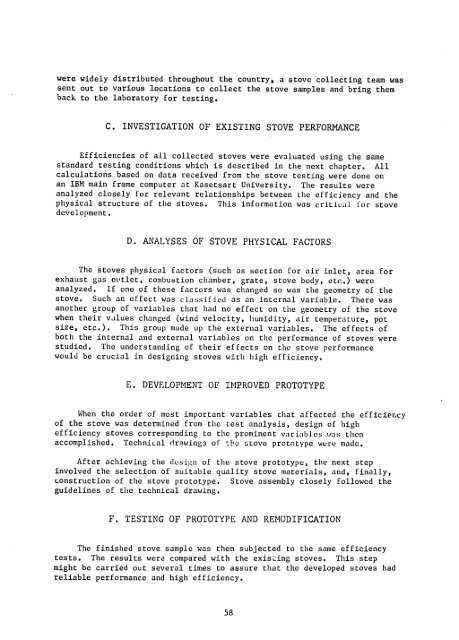improved biomass cooking stove for household use - (PDF, 101 mb ...
improved biomass cooking stove for household use - (PDF, 101 mb ...
improved biomass cooking stove for household use - (PDF, 101 mb ...
You also want an ePaper? Increase the reach of your titles
YUMPU automatically turns print PDFs into web optimized ePapers that Google loves.
were widely distributed throughout the country, a <strong>stove</strong> collecting team was<br />
sent out to various locations to collect the <strong>stove</strong> samples and bring them<br />
back to the laboratory <strong>for</strong> testing.<br />
C. INVESTIGATION OF EXISTING STOVE PERFORMANCE<br />
Efficiencies of all collected <strong>stove</strong>s were evaluated using the same<br />
standard testing conditions which is described in the next chapter. All<br />
calculations based on data received from the <strong>stove</strong> testing were done on<br />
an IBM main frame computer at Kasetsart University. The results were<br />
analyzed closely <strong>for</strong> relevant relationships between the efficiency and the<br />
physical structure of the <strong>stove</strong>s. This in<strong>for</strong>mation was critical <strong>for</strong> <strong>stove</strong><br />
development.<br />
D. ANALYSES OF STOVE PHYSICAL FACTORS<br />
The <strong>stove</strong>s physical factors (such as section <strong>for</strong> air inlet, area <strong>for</strong><br />
exhaust gas outlet, co<strong>mb</strong>ustion cha<strong>mb</strong>er, grate, <strong>stove</strong> body, etc.) were<br />
analyzed. If one of these factors was changed so was the geometry of the<br />
<strong>stove</strong>. Such an effect was classified as an internal variable. There was<br />
another group of variables that had no effect on the geometry of the <strong>stove</strong><br />
when their values changed (wind velocity, humidity, air temperature, pot<br />
size, etc.). This group made up the external variables. The effects of<br />
both the internal and external variables on the per<strong>for</strong>mance of <strong>stove</strong>s were<br />
studied. The understanding of their effects on the <strong>stove</strong> per<strong>for</strong>mance<br />
would be crucial in designing <strong>stove</strong>s with high efficiency.<br />
E. DEVELOPMENT OF IMPROVED PROTOTYPE<br />
When the order of most important variables chat affected the efficiency<br />
of the <strong>stove</strong> was determined from the test analysis, design of high<br />
efficiency <strong>stove</strong>s corresponding to the prominent variables was then<br />
accomplished. Technical drawings of thu <strong>stove</strong> prototype were made.<br />
After achieving the dusign of the <strong>stove</strong> prototype, the next step<br />
involved the selection of suitable quality <strong>stove</strong> materials, and, finally,<br />
construction of the <strong>stove</strong> prototype. Stove asse<strong>mb</strong>ly closely followed the<br />
guidelines of the technical drawing.<br />
F. TESTING OF PROTOTYPE AND REMODIFICATION<br />
The finished <strong>stove</strong> sample was then subjected to the same efficiency<br />
tests. The results were compared with the existing <strong>stove</strong>s. This step<br />
might be carried out several times to assure that the developed <strong>stove</strong>s had<br />
reliable per<strong>for</strong>mance and high efficiency.<br />
58

















